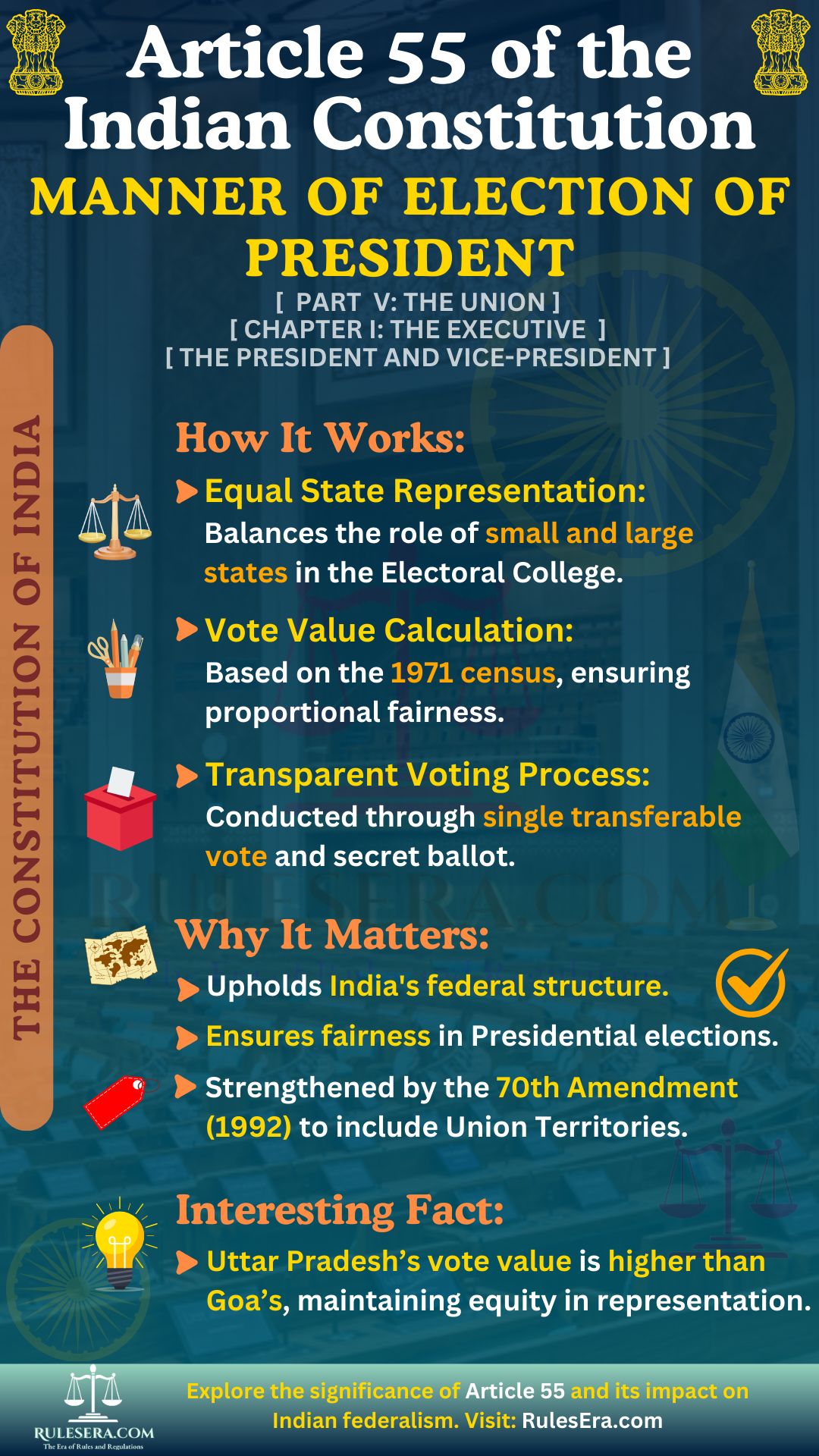Part V: The Union
Chapter I: The Executive
Article 55: Manner of Election of President

--- Original Article ---
(1) As far as practicable, there shall be uniformity in the scale of representation of the different States at the election of the President.
(2) For the purpose of securing such uniformity among the States inter se as well as parity between the States as a whole and the Union, the number of votes which each elected member of Parliament and of the Legislative Assembly of each State is entitled to cast at such election shall be determined in the following manner:—
- every elected member of the Legislative Assembly of a State shall have as many votes as there are multiples of one thousand in the quotient obtained by dividing the population of the State by the total number of the elected members of the Assembly;
- If, after taking the said multiples of one thousand, the remainder is not less than five hundred, then the vote of each member referred to in sub-clause (a) shall be further increased by one;
- Each elected member of either House of Parliament shall have such number of votes as may be obtained by dividing the total number of votes assigned to the members of the Legislative Assemblies of the States under sub-clauses (a) and (b) by the total number of the elected members of both Houses of Parliament, fractions exceeding one-half being counted as one and other fractions being disregarded.
(3) The election of the President shall be held in accordance with the system of proportional representation by means of the single transferable vote and the voting at such election shall be by secret ballot.
1 [Explanation.—In this article, the expression “population” means the population as ascertained at the last preceding census of which the relevant figures have been published: Provided that the reference in this Explanation to the last preceding census of which the relevant figures have been published shall, until the relevant figures for the first census taken after the year 2026 have been published, be construed as a reference to the 1971 census.]
Explanation
Article 55 of the Constitution of India lays down the manner in which the President of India is elected. This article ensures proportional representation of both the Union and the States in the election process, maintaining uniformity across the different States and Parliament. The system established is designed to uphold democratic principles by ensuring equal weightage of votes among the electorate, comprising members of Parliament and Legislative Assemblies of the States.
Key Provisions
- Uniformity in Representation (Clause 1): The election process ensures an equitable representation of States, regardless of their size, maintaining uniformity in the voting process.
- Calculation of Votes for Legislators (Clause 2): This clause defines how votes are calculated based on the population of each State, ensuring proportional representation.
- System of Voting (Clause 3): The election of the President follows the system of proportional representation with a single transferable vote, conducted by secret ballot to maintain confidentiality.
Amendments and Real-Life Examples
- Amendments: The Constitution (Seventieth Amendment) Act, 1992 allowed members of Legislative Assemblies of Union Territories like Delhi and Puducherry to participate in the Presidential election.
- Real-Life Example: In the 2022 Presidential election, the number of votes assigned to members of Legislative Assemblies reflected the population of their respective States, ensuring proportional representation.
Historical Significance
Article 55 reflects the federal nature of the Indian Constitution, ensuring that both the Union and the States have a role in electing the President. The system of proportional representation ensures fairness and equality in the electoral process.
Legislative History
Article 55 was initially drafted as Article 44 of the draft constitution and was incorporated into the final Constitution after extensive deliberation on December 13, 1948.
Debates and Deliberations
During the Constituent Assembly debate on Article 44 (now Article 55) on December 13, 1948, Dr. B.R. Ambedkar proposed a key amendment in clause (2)(c) to replace "such member" with "elected members of both Houses of Parliament." This amendment aimed to bring uniformity between the States and the Parliament in the electoral process.
Another important intervention came from Mahavir Tyagi, who criticized the proportional representation system, arguing that it was more suited for electing multiple individuals rather than a single office like the President. Tyagi suggested that a majority preferential voting system, similar to the Irish method, would be more appropriate. He also questioned the adequacy of the population data from the 1941 census, calling it outdated, especially in light of the partition and subsequent demographic changes.
In response to concerns over outdated census data, Pandit Lakshmi Kanta Maitra and Naziruddin Ahmad echoed the need for more accurate population figures, particularly in regions like Punjab, Bengal, and Sindh, which had seen major shifts in population following the partition. However, Dr. B.R. Ambedkar clarified that the most recent census figures would be used and reassured the Assembly that the government would address population data issues in the future.
Despite opposition from Shri Mahavir Tyagi and Thakkar Bapa, who pushed for a new census before the elections, the Assembly ultimately accepted Dr. B.R. Ambedkar's approach. The formula for determining the value of each vote was adopted, and the system of proportional representation for electing the President was formalized.
Frequently Asked Questions (FAQs):
Votes are calculated based on the population of each State, ensuring proportional representation among elected members of Parliament and Legislative Assemblies.
The election follows the system of proportional representation with a single transferable vote, conducted through a secret ballot to ensure confidentiality.